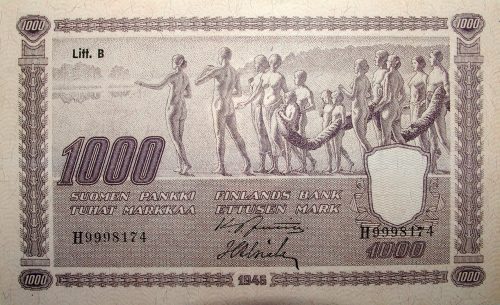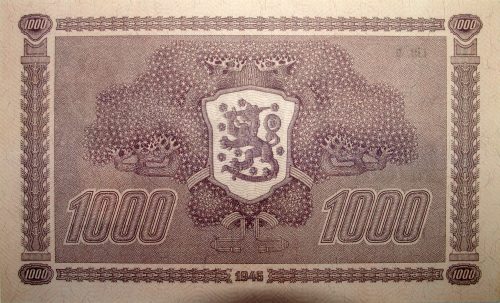P034
Paper, VF+, Litt. B
204 mm x 120 mm (8” x 4-3/4”)
HISTORY: In March 1917, tsar Nicholas II (1868–1918) abdicated his family rule of Russia in the wake of an angry communist revolution. Vladimir Lenin (1870–1924) came out of exile to lead the revolution toward victory in October. The Grand Duchy of Finland, an autonomous state of the Russian Empire since 1809, declared its independence on December 6, 1917. The following year, Finland became a republic.
OBVERSE: The Finland Mint began issuing the markkaa (1 markkaa = 100 cents) in various denominations. In 1922, Finnish/American architect Gottlieb Eliel Saarinen (1873–1950) was commissioned to design the obverse of their “TUHAT (1000) MARKKAA.” As an architect, Saarinen was renowned for his Art Nouveau building designs and brought that same element of design to this Finnish note. He gives us an allegorical scene, illustrating a procession of several families of men, women, and children, walking slowly toward a rising sun along a lakeshore, naked or partially draped. Some are carrying a long garland, perhaps to ritually float upon the lake waters in celebration of Finnish independence.
The Saarinen design seems to have met with some controversy when first issued but apparently was not long-lived. It was in continuous use on the 1000 markkaa for three decades. “Litt. B” was introduced in 1945 with a reddish hue, as seen on this note, and remained in print until 1955. There is no visible watermark inside the blank shield. The 500 markkaa also bears a similar theme by Saarinen.
REVERSE: Created by a mint engraver, the centerpiece dominates with the Finnish coat of arms, a unique crowned lion, wrapped around a linden tree in full blossom. The coat of arms was created as early as circa 1580.



